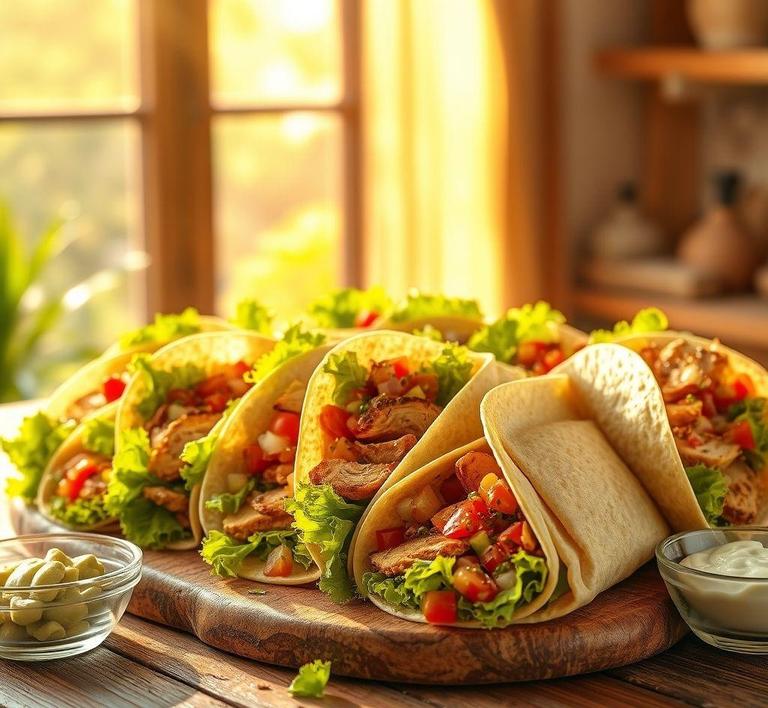If you’ve ever found yourself with a bunch of tortilla wraps that you can’t quite finish before they start to go stale, you might be wondering if it’s okay to refreeze them. The good news is, you can! Refreezing tortilla wraps is a great way to preserve their freshness and prevent waste. However, it’s important to know the right method to do so in order to keep them soft and flavorful for future use. In this guide, we’ll walk you through the process step by step, offering tips on how to safely refreeze your tortillas and avoid any potential mishaps, so you can enjoy them just as much the second time around!
Can You Refreeze Tortilla Wraps?

Tortilla wraps are a staple in many households, whether they’re used for making tacos, wraps, quesadillas, or just eaten with a side of salsa. Due to their versatility and convenience, tortillas often end up being bought in bulk, stored in freezers, and used sporadically. But what happens if you find yourself with leftover tortilla wraps, and you want to store them for later use? Can you refreeze tortilla wraps, or is it best to toss them out?
The good news is yes, you can refreeze tortilla wraps. However, this process isn’t as straightforward as simply throwing them back into the freezer. Refreezing food items, including tortillas, can lead to changes in texture and flavor. This is due to the formation of ice crystals during the freezing and thawing process, which can affect the quality of the product. So while it’s safe from a food safety standpoint to refreeze tortilla wraps, there are some important considerations to keep in mind to preserve their quality.
How To Refreeze Tortilla Wraps?
To properly refreeze tortilla wraps without compromising their quality, it’s essential to follow a few steps. The process may take a bit more care than just placing them back in the freezer, but it ensures that they will remain edible and maintain their best possible texture.
1. Ensure Proper Thawing First
The first rule of thumb when working with frozen tortillas is that they should be thawed correctly before refreezing. Tortillas should be thawed at room temperature or in the fridge, depending on how much time you have. Thawing them in the microwave or oven can cause them to become too soft and sticky, making them more difficult to refreeze properly. Allow them to reach room temperature or thaw slowly in the fridge.
2. Separate The Tortillas
Before refreezing, it’s crucial to separate the tortillas. If they are stuck together after thawing, they can become a clumpy, sticky mess when frozen again. Use parchment paper, wax paper, or plastic wrap to separate each tortilla. This will allow you to pull out individual wraps when you need them, without having to defrost the entire batch.
3. Wrap In Plastic Or Use A Freezer Bag
Once you’ve separated the tortillas, tightly wrap them in plastic wrap or place them in a resealable freezer bag. If you choose a freezer bag, try to remove as much air as possible to prevent freezer burn. You could also vacuum-seal the tortillas if you have the equipment available. This helps lock in moisture and preserve the tortilla’s texture.
4. Label And Date The Package
It’s always a good idea to label the package with the date you’re freezing the tortillas. This will help you keep track of how long they’ve been in the freezer and ensure that they’re used within a reasonable timeframe. Tortillas can last up to 3 months in the freezer without a significant loss of quality, but after that, they might start to lose their flavor and texture.
5. Freeze As Quickly As Possible
For optimal preservation of flavor and texture, aim to freeze the tortillas as quickly as possible after packing them. If you have multiple tortillas, try to avoid stacking them too thickly in the freezer. The faster they freeze, the smaller the ice crystals that form, and the better the quality will be when they are thawed and reheated.
Quality Impact
Refreezing tortilla wraps can have a noticeable effect on their quality. Several factors come into play here, including the texture, flavor, and overall usability of the tortillas once they’ve been refrozen. Understanding these impacts can help you decide if it’s worth the extra effort or if you’d prefer to use fresh tortillas instead.
1. Texture Changes
The most significant impact of refreezing tortilla wraps is on their texture. Tortillas are thin, flat, and flexible, which makes them more prone to drying out when exposed to freezing and thawing. Each cycle of freezing and thawing allows ice crystals to form, and these crystals can puncture the structure of the tortilla, causing it to become drier, less pliable, and sometimes even brittle. The result is that the tortillas may crack when you try to fold them for a wrap or taco, or they may tear apart more easily when you heat them up.
However, by following the proper refreezing steps-such as wrapping them tightly and ensuring they are separated-these texture changes can be minimized, though not entirely avoided.
2. Flavor Deterioration
The flavor of tortilla wraps can also be affected by refreezing. The longer they stay frozen, the more they can begin to lose their freshness. Freezer burn, which occurs when food is exposed to air and moisture during freezing, can result in a stale or off taste. Proper wrapping and air-tight storage are essential to prevent this from happening, but there will always be a slight degradation in taste.
If your tortillas have been stored for a while before being refrozen, it’s a good idea to inspect them for any signs of freezer burn (such as discoloration or dry spots) before using them.
3. Moisture Loss
Tortillas are made with ingredients that contain moisture, such as flour, oil, and water. When frozen, some of that moisture can be lost, especially during thawing and refreezing. This can lead to the tortillas feeling dry and less soft when they are heated up. While the moisture loss is typically subtle, it can be noticeable if you’re used to the fresh, soft texture of a newly purchased tortilla.
refreezing tortilla wraps is absolutely possible, but there are a few trade-offs when it comes to quality. While refrozen tortillas remain safe to eat, the texture and flavor can suffer over time. If you decide to refreeze them, following the proper techniques-separating each tortilla, tightly wrapping them, and minimizing exposure to air-can help maintain their integrity. However, it’s important to manage your expectations: the more times you freeze and thaw them, the more the texture will change, and the less fresh they will taste.
If you’re only refreezing a small batch of tortillas that you plan to use relatively soon, the quality may not suffer too much. However, if you’re storing tortillas for a long period, or you plan to refreeze them multiple times, it might be best to limit how many times you freeze and thaw them to keep the quality in check. Always remember that fresh tortillas will generally deliver the best flavor and texture, but with a little care, frozen tortillas can still make for a perfectly satisfying meal.
Is It Safe To Refreeze Tortilla Wraps?
Refreezing tortilla wraps is a question that often arises when people are unsure whether their frozen food can be safely refrozen after thawing. The safety and quality of refrozen tortilla wraps depend largely on the process in which they are thawed and refrozen. Tortillas, whether flour, corn, or other variations, are quite delicate and prone to texture changes if not handled properly.
Safety Considerations For Refreezing Tortillas
The general rule of thumb with frozen food is to only refreeze items that have been thawed in the refrigerator, not at room temperature. This helps avoid any harmful bacterial growth that can occur when food is left to sit out for too long. If tortilla wraps are thawed in the fridge, they can typically be refrozen without major safety risks, as long as they haven’t been exposed to temperatures that promote bacterial growth (i.e., above 40°F or 4°C for an extended period).
Another factor to consider is how long the tortillas have been stored before being thawed. If they’ve been frozen for a long time (months rather than weeks), the quality may degrade even if they’re safely refrozen. Tortillas, like most baked goods, tend to lose moisture over time, which can make them dry, tough, or rubbery once refrozen.
Signs That Tortilla Wraps Should Not Be Refrozen
Despite the general safety of refreezing tortillas, there are some situations where it’s best to avoid putting them back into the freezer. Here are a few key signs that your tortillas should not be refrozen:
-
Visible Signs of Freezer Burn:
Freezer burn happens when food is exposed to air and moisture in the freezer, causing it to dry out. Tortillas affected by freezer burn will show signs of discoloration (such as white, frosty patches) and will lose their original texture and flavor. These tortillas can still be eaten but will be less than ideal in terms of taste and texture, so it’s best not to refreeze them if they’ve been freezer-burned.
-
Excessive Dryness:
Tortillas that have been thawed and left out for too long may dry out. This is a major indicator that refreezing is not a good option. When tortillas are too dry, they’ll become brittle and may crack or break easily after refreezing, leading to a poor eating experience.
-
Mold or Spoilage:
Any tortilla wraps that show signs of mold, unusual odor, or discoloration should be discarded. Refreezing tortillas that have already started to spoil could not only result in unappetizing food but also introduce harmful bacteria or toxins.
-
Improper Thawing:
If tortillas were thawed improperly (such as being left at room temperature for too long), they may have already begun to degrade. If they’ve been sitting at an unsafe temperature for more than two hours, it’s best not to risk refreezing them.
Common Refreezing Mistakes
Even if you’re in the clear safety-wise, there are still some common mistakes that can affect the quality of your refrozen tortillas. Here are some of the most frequent errors people make when refreezing tortilla wraps:
-
Refreezing Multiple Times:
The more times tortillas are frozen and thawed, the worse the texture will be. Each time tortillas freeze, they lose moisture, which results in a dry, hard texture. Refreezing multiple times accelerates this process, making them less soft and pliable. It’s best to freeze tortillas once and consume them within a reasonable time.
-
Not Wrapping Properly:
Tortillas need to be well-wrapped when freezing to prevent air exposure and freezer burn. If you’re not using an airtight container or wrapping them tightly in foil or plastic wrap, the tortillas will lose their flavor and texture. Even with refreezing, the packaging plays a huge role in maintaining quality.
-
Refreezing Large Quantities All at Once:
When you thaw a batch of tortillas, it can be tempting to just refreeze the entire stack all at once. However, it’s better to freeze them in smaller portions. This way, when you thaw and refreeze, you don’t compromise the entire batch at once. This also makes it easier to defrost the exact number you need without needing to thaw the whole pile again.
-
Thawing Too Quickly:
Refreezing tortilla wraps after they have been thawed improperly can lead to an uneven texture. If they are left out too long at room temperature or placed in the microwave on high to thaw too quickly, the tortilla’s structure may break down, making them less pliable and more prone to cracking. Slow thawing in the refrigerator is always the best route.
Tips And Tricks
To help you maximize the lifespan and quality of your tortilla wraps, here are some tips and tricks:
-
Pre-Freezing Tortillas:
If you’re planning to freeze tortillas from the get-go, pre-freezing them is a great idea. Lay the tortillas flat on a baking sheet and freeze them for about an hour before stacking them. This will prevent them from sticking together in one solid block, making it easier to remove individual tortillas when needed.
-
Use Parchment Paper:
When stacking tortillas for freezing, place a layer of parchment paper or wax paper between each tortilla. This helps them separate easily and ensures they don’t stick together, making it much easier to grab a single tortilla without defrosting the entire batch.
-
Vacuum Sealing:
For a longer-lasting, higher-quality freezer experience, consider vacuum sealing your tortillas. This eliminates air exposure, which is the primary cause of freezer burn, and keeps your tortillas fresh for months. Plus, it can help preserve the texture.
-
Thaw Gradually:
Always thaw tortillas in the fridge overnight or for several hours. The gradual process will help preserve the moisture content, keeping the tortillas soft and pliable. If you need to speed up the thawing, you can microwave them for 15-30 seconds with a damp paper towel over them, but be careful not to overheat them.
-
Reviving Stale Tortillas:
If you’ve thawed tortillas and they’ve become a little dry or stiff, you can revive them by lightly steaming them or wrapping them in a damp towel and microwaving them for a few seconds. This can help restore their flexibility.
Conclusion
In conclusion, refreezing tortilla wraps can be safe as long as you follow proper procedures for thawing, packaging, and handling. However, it’s important to be mindful of signs of spoilage, freezer burn, or dryness, which can indicate that the tortillas are no longer suitable for refreezing. Additionally, common mistakes like refreezing multiple times, improper packaging, or thawing too quickly can all contribute to poor quality tortillas once refrozen. By following the best practices and tips for freezing, storing, and thawing, you can maximize the shelf life of your tortillas without sacrificing too much in terms of texture or flavor.


